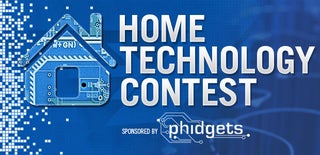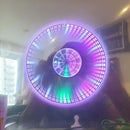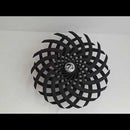Introduction: Arduino Controlled Room Heating System
The first thing that came to my mind when I started micro-controller programming was to set an automatic room heating cum humidifier system. Bangalore has a very confusing weather - especially for new-comers. The temperature is generally moderate, but nights can sometimes become very cold. However, on other days, the nights are warm and if you have a heater on - it becomes uncomfortable. Also, since the weather is generally moderate - automatic heating solutions are not available commercially.
Hence, one of the first projects I made on an arduino was a temperature and humidity controller.
Features:
- Controls a 2-relay board - one for a room heater and one for a humidifier.
- Checks the temperature and humidity every 10 minutes - this can be set in the code
- The algorithm is very simple - Switch off the heater if the temperature goes 1 degree above the set-point and switch it on again if it goes below the set-point. This is similar to most commercial systems.
- The humidifier gets switched on if the humidity is below 40% and gets switched off if it goes above 60%.
- Uses the EEPROM to save the preset
- Has one button that is used to change the preset - single click to increase the temperature by 1 degree, long press to decrease the temperature by 1 degree. The temperature circles between 25 and 30 degree centigrade.
Step 1: Electronics
- Atmega 328P-PU (without bootloader)
- 16 MHz Crystal
- 2 x 22 pf capacitors
- LM 7805
- 1 uF + 10uF Electrolytic capacitors
- 10k Resistor
- DHT11 Breakout Board or similar (http://cgi.ebay.in/ws/eBayISAPI.dll?ViewItem&item=...)
- 2 Channel Relay Board
- 1 push-button switch
- 16x2 character LCD
- 10k pot
- 9-12V 1Amp power supply
- Extension cord
- Wires
- General purpose PCB
Instructions for creating and using a "standalone arduino" can be found at http://dushyant.ahuja.ws/2013/10/standalone-arduin...
Step 2: The Circuit
The Fritzing layout is above. I know it looks extremely confusing – but this was the best I could do (this was my first attempt at using fritzing).
The circuit is actually very simple:
- Relay 1 is connected to pin A1
- Relay 2 is connected to pin A2
- A switch is connected to between pin A5 and ground - it uses an internal pullup resistor to maintain a HIGH value
- DHT 11 is connected to pin 13
- LCD pins D4-D7 are connected to pins 5-8
- LCD RS pin is connected to pin 11
- LCD EN pin is connected to pin 12
- The NO sockets of the relays need to be connected between the 110/220 V power and the plug point
- Details to connect the LCD can be found at: https://learn.adafruit.com/character-lcds/wiring-a...
Step 3: The Code
The code utilises the following libraries (and all thanks to the authors of these libraries):
- OneButton: http://www.mathertel.de/Arduino/OneButtonLibrary.a...
- DHT11: http://playground.arduino.cc/main/DHT11Lib
- Timer: https://github.com/JChristensen/Timer
- EEPROM & LiquidCrystal: both part of the Arduino IDE
#include "OneButton.h"
#include "EEPROM.h"
#include "Timer.h"
#define RELAY1 A1 // Connect humidifier to Relay1
#define RELAY2 A2 // Connect heater to Relay2
#define TEMP_SET 25 // Starting Temperature
#define MAX_TEMP 30 // Max Temperature
#define HUM_SET 40 // Threshold humidity
#define HUM_SET2 60
#define SWITCH_PIN A5 // Connect the switch between pin A5 and ground
#define CYCLE 10 //Time in minutes for each cycle
#include "LiquidCrystal.h"
#define LCD_RS 11 // * LCD RS pin to digital pin 12 - Green
#define LCD_EN 12 // * LCD Enable pin to digital pin 11 - Yellow
#define LCD_D4 5 // * LCD D4 pin to digital pin 5 - Blue
#define LCD_D5 6 // * LCD D5 pin to digital pin 6 - Blue
#define LCD_D6 7 // * LCD D6 pin to digital pin 7 - Blue
#define LCD_D7 8 // * LCD D7 pin to digital pin 8 - Blue
#include "dht11.h"
#define DHT11PIN 13
dht11 DHT11;
LiquidCrystal lcd(LCD_RS, LCD_EN, LCD_D4, LCD_D5, LCD_D6, LCD_D7);
int temp_set;
Timer t;
OneButton button1(SWITCH_PIN, true);
void setup() {
pinMode(DHT11PIN, INPUT);
pinMode(LCD_RS, OUTPUT);
pinMode(LCD_EN, OUTPUT);
pinMode(LCD_D4, OUTPUT);
pinMode(LCD_D5, OUTPUT);
pinMode(LCD_D6, OUTPUT);
pinMode(LCD_D7, OUTPUT);
pinMode(RELAY1, OUTPUT);
pinMode(RELAY2, OUTPUT);
lcd.begin(16, 2);
Serial.begin(9600);
if(EEPROM.read(0) >= MAX_TEMP+1){
EEPROM.write(0,TEMP_SET);
temp_set=TEMP_SET;
}
else {temp_set=EEPROM.read(0);}
lcd.print("Setpoint: ");
lcd.print(temp_set); // Display the setpoint temperature for 2 sec
delay(2000);
checkTemp(0);
t.every(60000*CYCLE,checkTemp,(void*)0);
button1.attachClick(tempPlus);
button1.attachPress(tempMinus);
}
void loop() {
// put your main code here, to run repeatedly:
button1.tick();
t.update();
}
void tempPlus(){
Serial.println("Plus");
temp_set++;
if (temp_set > MAX_TEMP) temp_set = TEMP_SET; // Cycle between TEMP_SET and MAX_TEMP
lcd.clear();
lcd.print("Setpoint: ");
lcd.print(temp_set);
EEPROM.write(0,temp_set);
delay(1000);
checkTemp(0);
}
void tempMinus(){
Serial.println("Minus");
temp_set--;
if (temp_set < TEMP_SET) temp_set = MAX_TEMP; // Cycle between TEMP_SET and MAX_TEMP
lcd.clear();
lcd.print("Setpoint: ");
lcd.print(temp_set);
EEPROM.write(0,temp_set);
delay(2000);
checkTemp(0);
}
void checkTemp(void* context)
{
int chk = DHT11.read(DHT11PIN);
// Serial.print("Read sensor: ");
/* switch (chk)
{
case DHTLIB_OK:
// Serial.println("OK");
break;
case DHTLIB_ERROR_CHECKSUM:
// Serial.println("Checksum error");
break;
case DHTLIB_ERROR_TIMEOUT:
// Serial.println("Time out error");
break;
default:
lcd.println("Unknown error");
break;
}*/
lcd.setCursor(0, 0);
Serial.println(DHT11.humidity);
lcd.print("Humidity: ");
lcd.print((float)DHT11.humidity, 2);
lcd.setCursor(0, 1);
lcd.print("Temp: ");
lcd.print((float)DHT11.temperature, 2);
Serial.println(DHT11.temperature);
if(DHT11.humidity < HUM_SET2){
digitalWrite(RELAY1, HIGH);
Serial.println("H1");
}
if (DHT11.humidity > HUM_SET) {
digitalWrite(RELAY1,LOW);
Serial.println("H0");
}
if(DHT11.temperature < temp_set){
digitalWrite(RELAY2, HIGH);
Serial.println("T1");
}
if (DHT11.temperature > temp_set){
digitalWrite(RELAY2,LOW);
Serial.println("T0");
}
}
Step 4: Assembly
The assembly was slightly difficult as fitting the entire circuit, LCD, Relay board and power adapter inside the extension cord was a tight fit. However, you can see how everything was fit inside in the photgraphs above.
Also, this would depend a lot on the model of your extension cord and hence there is no "right way"
Step 5: Final Result
Features:
- Controls a 2-relay board - one for a room heater and one for a humidifier.
- Checks the temperature and humidity every 10 minutes - this can be set in the code
- The algorithm is very simple - Switch off the heater if the temperature goes 1 degree above the set-point and switch it on again if it goes below the set-point. This is similar to most commercial systems.
- The humidifier gets switched on if the humidity is below 40% and gets switched off if it goes above 60%.
- Uses the EEPROM to save the preset
- Has one button that is used to change the preset - single click to increase the temperature by 1 degree, long press to decrease the temperature by 1 degree. The temperature circles between 25 and 30 degree centigrade.
Step 6: Extending the Functions
The following pins are accessible from the outside:
- RX and TX pins
- Reset pin (to program the arduino)
- pin 13
- Two sets of +5 and GND
By replacing the DHT11 and reprogramming, this can be used as a smart power strip. Some of the uses I could think up are:
- Replace the DHT11 with a soil hygrometer - can be used to switch on a pump to water plants when the soil becomes dry.
- Replace the DHT11 with an LM35 or PT100 - and create a sous vide cooker
- Connect a Bluetooth HC-05 module to the RX and TX ports - an voila - a bluetooth controlled power strip that can be controlled from a mobile phone
- Replace the DHT11 with a PIR sensor, and the heaters with a lamp - and you get a motion controlled lamp
Suggestions welcome - please let me know how you would extend this in the comments below.
Step 7: References and Links
- Original blog post: http://dushyant.ahuja.ws/2013/11/standalone-temperature-and-humidity-control/
- Project Github: https://github.com/dushyantahuja/Smart-Power-Strip
Further Assembly details:
- Standalone Arduino: http://dushyant.ahuja.ws/2013/10/standalone-arduino/
- LCD Assembly: https://learn.adafruit.com/character-lcds/wiring-a-character-lcd
The code utilises the following libraries (and all thanks to the authors of these libraries):
- OneButton: http://www.mathertel.de/Arduino/OneButtonLibrary.a...
- DHT11: http://playground.arduino.cc/main/DHT11Lib
- Timer: https://github.com/JChristensen/Timer
- EEPROM & LiquidCrystal: both part of the Arduino IDE

Second Prize in the
Home Technology Contest

Participated in the
Epilog Challenge VI











